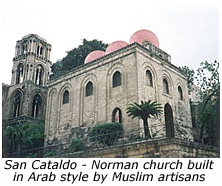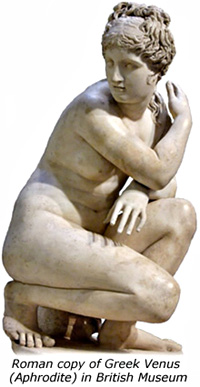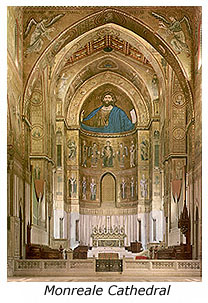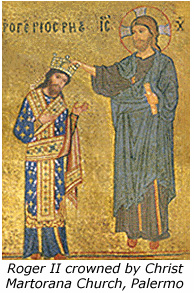The Religions of Sicily

 The
religions of Sicily are the faiths of the Mediterranean. Historical continuity is overpowering in such a place. Sicilian history offers
an ideal view of the development of religion in the Western World.
Coming from North or South, East or West, every civilisation
that has conquered Sicily has left its theological
influence here. In Sicily today we find Sicanian,
Greek and Roman temples. The historical traces of synagogues,
mosques and Paleo Christian churches and catacombs are more difficult
to identify. By the 6th century, Sicily was essentially Christianized,
with small Jewish communities, and in the 9th century Islam arrived.
The
religions of Sicily are the faiths of the Mediterranean. Historical continuity is overpowering in such a place. Sicilian history offers
an ideal view of the development of religion in the Western World.
Coming from North or South, East or West, every civilisation
that has conquered Sicily has left its theological
influence here. In Sicily today we find Sicanian,
Greek and Roman temples. The historical traces of synagogues,
mosques and Paleo Christian churches and catacombs are more difficult
to identify. By the 6th century, Sicily was essentially Christianized,
with small Jewish communities, and in the 9th century Islam arrived.
 A Land of Faiths
A Land of Faiths
Mythology
Judaism
Islam
Christianity
Orthodoxy
Catholicism
Protestantism
A Multicultural Renaissance
A Land of Faiths
In defining the relationships of peoples
whose fundamental differences are rooted in matters of
ethnicity or religion, "tolerance" is one thing, "equality" quite another. The latter
defined Norman Sicily's "Great Experiment." It is important, from
a historical point of view, to remember that within the great Western religions there originally were no denominations per se. Jews
were not Orthodox or Conservative, Christians were not Catholic or Protestant, Muslims were not Sunni
or Shiite (though that split occurred earlier than those within Judaism and Christianity). Such terms
came into wide use later, with subsequent schisms in these religions. Historically, Judaism could be said to
be the first monotheistic faith in the Mediterranean region, supplanting mythology in many
areas. Christianity built upon Judaism, and Islam shared certain elements of both. The "Golden Age"
of multicultural (and multi-faith) Sicily lasted throughout the Norman era from around 1070 until about 1200, though
some historians extend it by a few more decades, through the reign of Frederick II, to 1250.
Following the death of that distinguished monarch, Sicily's Muslims gradually converted to Christanity, and
over time the remaining Byzantine (Greek Orthodox) clergy were replaced by Latin (Roman Catholic) bishops and priests.
The Jewish population disappeared with an infamous Spanish decree of 1492. Many Sicilian Jews
converted to Christianity, but just as many emigrated. By 1500, Sicily was Roman Catholic except for a few Albanian
Orthodox communities whose churches soon affiliated themselves with Rome.
In the words of John Julius Norwich, "Norman Sicily stood forth in Europe—and indeed in the
whole bigoted medieval world—as an example of tolerance and enlightenment, a lesson in the respect that
every man should feel for those whose blood and beliefs happen to differ from his own."
 Mythology
Mythology
Persephone, Demeter, Arethusa,
Alpheus, Aphrodite, Theseus,
Daedalus, Icarus, Minos, Dionysos, Charybdis, Hades,
Hercules, Jason, Thetis, Aeolus, Polyphemus, Odysseus (Ulysses). Their names resound
in the Greek myths of antiquity, and each knew Sicily, the Greeks' New World, intimately. The Cyclopes and Vulcan (Hephaestus)
lived on volcanic Etna, the sacred mountain of Sicily's Greeks, Aeolus
and Vulcan dwelled in the islands north of Sicily, Scylla guarded the Strait of Messina, Persephone was
abducted outside Enna, Arethusa emerged at Syracuse. The Sicans, Sikels, Elymians, Phoenicians, Carthaginians
and ancient Greeks were polytheistic; they created their own Gods. Like the Elymians, Sicans and Sicels, the
Romans adopted the Greek gods as their own. Yet, unlike the Greeks, the Romans were pagans with little
faith in their own religion; Virgil's Aeneid was but an imitation of the Odyssey.
To consider classical mythology a quaint memory overlooks the fact that the very foundations of Western ethics
and democracy trace their origins from the Greece of Sophocles,
and the Sicily of Archimedes, Empedocles, Plato and Aeschylus—though there is little evidence that these
great thinkers considered mythology as anything more than a convenient cultural curiosity. When Saint Paul, who knew Greece, Sicily
and Rome, stated that the invisible must be understood by the visible, he was expressing an idea
more Greek than Hebrew. The Greeks were the first civilization to create deities in the human image,
complete with perfect human bodies and very human flaws. To the Siceliots, as the Sicilian Greeks
were known, the myths were an inspirational element of daily life in Sikelia (Sicily) rooted
in neolithic beliefs. The magnificent
Greek temples of Sicily attest to more than a people's passion; they represent the perfect union
of Humanity and Nature. After thirty centuries of progress, a combination still worth emulating. In
Malta, Europe's oldest temples were built
by the Proto-Sicanians of southeastern Sicily as early as 4,000 BC (BCE). Around three thousand years later, their
descendants built a Sicanian temple at Cefalù.
Judaism
Greek civilization created its divinities in the human image, while Hebrew culture held that humans were created in God's image. Western religious principles
are rooted in Judaic ones, but not all Semitic peoples (the Phoenicians,
for example) were Judaic in religion. The difference between God
and gods brought with it monumental implications for Mediterranean
society. As a people, the Jews were never more than a minority in
Sicily, but during the Middle Ages they comprised around eight percent of the island's
unique multicultural mosaic. There is evidence that Hebrew traders
resided in Sicily during the last centuries of Roman rule, but the first Jews in Sicily were brought
here as slaves by the Romans before the first century AD. The
successive Eastern Empire was more tolerant, and the first free Jewish
congregations grew after the time of Constantine the Great. At first,
these were communities of immigrants and descendants of former slaves, though it is clear that a number
of local people in search of faith, as opposed to mythology, converted
to Judaism. Intermarriage with Christians was not unusual in Sicily. Jewish temples were founded in
Sicily's port cities (Palermo, Messina, Syracuse) around the same time that
the first Christian churches were openly established. Sicily's jews lived more or less undisturbed
until the fifteenth century. The year 1492 signaled the unification of Spain, the European discovery
of America and the Inquisition's final banishment
of Jews from Spanish territories, including Sicily.  In Sicily, many Jews, being Sicilian in
almost every cultural sense, chose conversion (Sicily's anusim are descendants of those neofiti, similar
to the conversos and maranos of Spain), and a number of Sicilian
surnames reflect Jewish origins, or at least acknowledge a Jewish presence (Siino from Sion, Rabino from Rabbi).
Contemporary estimates of the number of Jewish Sicilians indicate that the Jewish populations of Palermo,
Siracusa (where Europe's oldest existing mikveh is preserved), Messina
and several other cities were considerable in 1492. In Palermo, the Jewish Quarter was located in the area between Piazza Ballarò and Via Roma; there is evidence
that the first merchants in the district of what is now Via dei Calderai were Jewish, and a synagogue stood near what is now Vicolo
Meschita. The star or shield of David (Magen David) appears in the Palatine Chapel, San Cataldo and various other churches of
Sicily's Norman era. It remains unclear whether this was an exclusively Jewish symbol in Italy during that period, as it was
also an Arab design motif and a Christian allusion to Jesus—who was of the House of David.
In Sicily, many Jews, being Sicilian in
almost every cultural sense, chose conversion (Sicily's anusim are descendants of those neofiti, similar
to the conversos and maranos of Spain), and a number of Sicilian
surnames reflect Jewish origins, or at least acknowledge a Jewish presence (Siino from Sion, Rabino from Rabbi).
Contemporary estimates of the number of Jewish Sicilians indicate that the Jewish populations of Palermo,
Siracusa (where Europe's oldest existing mikveh is preserved), Messina
and several other cities were considerable in 1492. In Palermo, the Jewish Quarter was located in the area between Piazza Ballarò and Via Roma; there is evidence
that the first merchants in the district of what is now Via dei Calderai were Jewish, and a synagogue stood near what is now Vicolo
Meschita. The star or shield of David (Magen David) appears in the Palatine Chapel, San Cataldo and various other churches of
Sicily's Norman era. It remains unclear whether this was an exclusively Jewish symbol in Italy during that period, as it was
also an Arab design motif and a Christian allusion to Jesus—who was of the House of David.
Islam
In medieval Sicily, Islam was inextricably bound to Arab culture, though
not all the world's Muslims were Arab. The Arabs ruled Sicily
for two centuries. Most of the Muslims in Sicily were Saracens
(Moors). More precisely, many were the descendants of Sicilian
women who had wed the conquering Moors, each of whom, under Koranic law, could take
as many as four wives. Many churches and synagogues survived (though new ones could not be built), and
not every Sicilian woman chose to wed a Muslim, despite
the economic advantages implicit in such a marriage. As recently
as the thirteenth century, there were Muslims at the royal court (popes cynically referred to Frederick II, who spoke Arabic,
as a "baptized sultan"), and the Muslim towns in Sicily were essentially Arabic in every way,
not unlike the Muslim towns in Spain. There is evidence to suggest that Frederick II considered his Muslim
soldiers more loyal than many of his unruly Christian knights and barons. Certain Muslim customs (veiling, fasting)
were essentially similar to practices that had been known
among Middle Eastern Jews and Christians, and Islam's Koranic scriptures
and precepts were not completely divorced from Judeo-Christian ones. Fasting (during Ramadan),
almsgiving (zakat), pilgrimage and even Mohammed's visit by the angel Gabriel are essential elements
of Islam. The Muslims respected Jews and Christians as "people of the book." Adopting a practice
of the Muslim emirs, some of Sicily's Norman kings kept harems. In Palermo alone, there were over a hundred
mosques and Koranic schools, and hundreds of imams, when the Normans arrived. A body of evidence suggests that
Islamic law as it existed in eleventh-century Sicily influenced the early
development English common law. By the time of the Vespers War (1282), there were no professed Muslims in Sicily. Frederick II's exiled
some of them to Lucera in Apulia for armed insurrection in 1246. Sicily's
Muslims converted a number of churches to mosques, and the Normans, in turn, rebuilt some of these as churches. Like many
Jews in 1493, most of Sicily's Muslims converted to Catholicism during the twelfth and thirteenth centuries, a fact borne witness by artifacts
such as a New Testament written in Arabic in Palermo during this period. Arab architects designed churches in
what has come to be known as the "Norman-Arab" style. (An Arabic
inscription is visible around the high cupola of the Martorana Church in Palermo.) On the present site of
Palermo Cathedral and its square once stood Sicily's largest mosque, and before that a Paleo Christian
basilica. A number of churches in central Palermo were built on the sites of mosques. In keeping with this
peculiar architectural tradition, the Archdiocese of Palermo some years ago gave a former church to the
city's growing Muslim community for use as a mosque. Veiled women
are an increasingly common sight in the city, where a pillar of the portico of Palermo Cathedral is
inscribed with the enduring Arabic words of the first sura of the Koran: God is Allah and Muhammed is His Prophet.
 Christianity
Christianity
There was already a small Christian community in
Syracuse when Saint Paul preached there, though in his time the
Christians were still a covert sect persecuted by the Empire. A number of Greek and Roman temples were eventually converted into
churches; Syracuse Cathedral, formerly the
Temple of Athena, is the most magnificent example still standing. The essence of the historical Church in Sicily is rooted
in the Byzantine East, in the tradition which is today preserved in the Orthodox Church. It began in Palestine. The Normans
arrived just a few years after the Great Schism (1054), in which
the Patriarch of Rome (the Pope) separated from communion with the other patriarchs
of the Church. The reasons for this were social as well as theological, but for most of Sicily's Christians the effect was not felt immediately.
Orthodoxy
The Norman kings, whose Italian conquests were sanctioned
by the Popes of Rome, are generally viewed, theologically speaking, as "Latinizers." Yet,
during the reign of Roger I the Archimandrite Neilos
Doxopatrios authored a book, published in Sicily,
refuting the supremacy of the Roman Pontiff. The cathedral of Cefalù
is distinctly Romanesque, with certain Gothic elements, while
the cathedral of Monreale, and the churches of the Martorana (Palermo)
and the Annunciation (Messina) are more similar to what one might
encounter in Greece. Despite eclectic styles, all were constructed during the same
period. The Martorana, in fact, was built specifically as an Orthodox place of worship.
The Schism's theological implications
became evident over time, as the Western
Church itself evolved. Superficially, statues replaced icons,
and the liturgy was altered. The mosaic icons in the Martorana,
the Palatine Chapel, Monreale Abbey and (to a lesser extent) Cefalù
Cathedral reflect a Byzantine heritage. They also indicate an
Orthodox presence for some time after the arrival of the Normans.
This was most evident in Sicily, but even the Normans' Royal Chapel
in the Tower of London is more typical of Orthodox churches than
it is of subsequent (Catholic) ones based on the Romanesque and
Gothic models. In social matters, the Schism paved the way for
a more Italianate (and Papal) orientation which, in retrospect, brought Sicily's
unique medieval interfaith experiment to an early demise. Yet Byzantine monasteries in northeastern Sicily's
scenic Nebrodi Mountains continued to thrive into the fourteenth century.
There came a new influx of Orthodox Christians into southern
Italy with the Albanian immigration of the 15th century. These
parishes soon became "Uniate"—being in union with Rome. Today, their liturgy
and customs are Orthodox but in fact they are Byzantine Rite parishes of the Catholic Church.
Catholicism
Sicily's early kings enjoyed the title and function of Apostolic (papal) Legate, though as a fundamental
principle of law the Sicilian Crown was granted not by any Pope but emanated from God Himself.
Ecclesiastical Sicily gravitated toward Rome very slowly indeed; occasional excommunication was something the
Norman and Swabian kings took in stride. The new dioceses founded in Sicily during the Norman period, in places
like Monreale and Patti, were under the canonical jurisdiction of Rome and used the Gallican Rite. Some of the
new bishops were Normans; Bishop Walter "of the Mill" (his name actually a misnomer based on a
mistranslation) was a cousin of the royal Hautevilles. Sicily's Eastern tradition didn't vanish immediately
but, like the Normans themselves, it was all but forgotten within a few centuries. Byzantine Venice, Bari and Ravenna
suffered the same fate.
 How was Catholicism different from Orthodoxy? There were theological matters, such as the controversial
"filoque" passage of the Creed, while the ecclesiastical primacy of one man (the Pope)
also distinguished Catholics from their Orthodox brethren, whose patriarchal leadership was
collegial. The Crusades were a
Catholic phenomenon. Latin's replacement of Greek as the liturgical language represented perhaps the least significant alteration.
Liturgy itself changed radically from that which existed in Norman times, and with it the role of the clergy.
Even the churches were different. The icon screen was omitted, and statues of saints (as opposed to the icons
or simple bas-reliefs of earlier times) became increasingly commonplace in Western churches, where the Gothic,
the Baroque and the Italian Romanesque supplanted the austere ecclesiastical architecture of the East. Over
time, the doctrines of Original Sin and the Immaculate Conception, Purgatory and indulgences, and other Latin
ideas rooted in late-medieval Western philosophy further distinguished Catholicism. One of the greatest differences
between East and West had little to do with theology as such, though it was rooted in Rationalism. Under the auspices
of the Catholic Church, the Renaissance, in all its glory, fostered a fundamental change in creative and philosophical
thought (Humanism), and the true end of the Middle Ages. But yet another schism, the Reformation, would challenge some of its ideas.
How was Catholicism different from Orthodoxy? There were theological matters, such as the controversial
"filoque" passage of the Creed, while the ecclesiastical primacy of one man (the Pope)
also distinguished Catholics from their Orthodox brethren, whose patriarchal leadership was
collegial. The Crusades were a
Catholic phenomenon. Latin's replacement of Greek as the liturgical language represented perhaps the least significant alteration.
Liturgy itself changed radically from that which existed in Norman times, and with it the role of the clergy.
Even the churches were different. The icon screen was omitted, and statues of saints (as opposed to the icons
or simple bas-reliefs of earlier times) became increasingly commonplace in Western churches, where the Gothic,
the Baroque and the Italian Romanesque supplanted the austere ecclesiastical architecture of the East. Over
time, the doctrines of Original Sin and the Immaculate Conception, Purgatory and indulgences, and other Latin
ideas rooted in late-medieval Western philosophy further distinguished Catholicism. One of the greatest differences
between East and West had little to do with theology as such, though it was rooted in Rationalism. Under the auspices
of the Catholic Church, the Renaissance, in all its glory, fostered a fundamental change in creative and philosophical
thought (Humanism), and the true end of the Middle Ages. But yet another schism, the Reformation, would challenge some of its ideas.
Protestantism
The Waldensian Church never had a strong presence in Sicily. A
Waldensian parish was established in Palermo after the Unification
(1860), their church having been more widespread in Piedmont,
the Savoys' realm. The Anglican Church was introduced early in
the 19th century with the arrival of several English mercantile families.
In Sicily, it is still represented in the "High Church"
tradition of the Church of England. When General George Patton
arrived in Palermo in 1943, it was at Holy Cross Anglican Church
(on Via Roma) that he worshipped, where he dedicated a plaque to
commemorate the American soldiers killed during Operation Husky,
the Sicilian campaign. Waldensians and Anglicans are Protestants in the Reform tradition.
A Multicultural Renaissance
The twentieth
century saw the arrival of other faiths in Sicily, and an increasing number of atheists. There has been a minor revival
of Eastern Orthodoxy, a strong Evangelical movement, and an increasing
number of Buddhists. Several mosques have been established by
North African immigrants. After nine centuries, Sicily has reclaimed
something of her multicultural religious heritage. It's one aspect
of twenty-first century Sicily that King Roger II would certainly recognize.